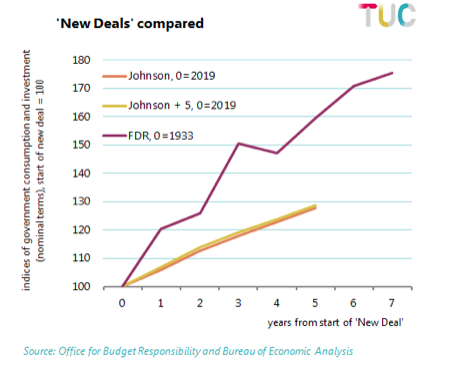We need £150bn by 2024, not £5bn, to match Roosevelt’s New Deal
Today, Boris Johnson proclaimed a “New Deal” for the “British people”. Widely regarded as a benchmark for constructive and decisive action in the face of recession, the New Deal takes its name from President Franklin Delano Roosevelt’s policies that brought to an end the US Great Depression of the 1930s.
How FDR's New Deal was different
Over his first five years in office Roosevelt increased government spending from $9 billion to $14 billion, an increase of around 50%, or 10% a year.
Coincidentally amounting to an increase of $5bn, this increase could not be further from the £5bn announced “to accelerate investment projects” by Boris Johnson today. Near a century of inflation means cash spending amounts are vastly different, and the figures are meaningless without the wider context of existing levels of spending.
What the government plans to spend
According to the Office for Budget Responsibility (OBR), the government’s spending last year was £480bn, over the next five years it will increase to £620bn by 2024. This amounts to an increase of 25%, or 5% a year. (Whether or not today’s £5 billion is included is incidental.)
(NB this is based on government consumption – i.e. wages and purchases from the private sector – and investment, excluding welfare and other transfer payments.)
The chart shows the path of this spending compared with the New Deal.

What the government needs to do to match the New Deal
To bring the level of UK spending up to the New Deal level would effectively mean doubling the planned increase in spending over 2019 to 2024. So rather than increase by £140bn (= 620–480) it should increase by £280bn, this is equal to £30bn a year, give or take. The increase needs to come in cumulatively, so £30bn in the first year, £60bn in the second, through to £150bn in the fifth year.
Adding up the annual increases over five years makes a total increase of £450 billion. In his speech Boris Johnson “served notice” that the government “will not be responding to this crisis with what people called austerity”. It is of course a good thing that he is rejecting the toxic advice of his predecessor George Osborne. But there is contempt here for the victims of Osborne and his successors. ‘People’ called it austerity because it was austerity – just ask the workers who have endured the worse decade for pay in two centuries, those who work in and use decimated public services, and the record numbers relying on food banks.
He goes on “I am conscious as I say all this that it sounds like a prodigious amount of government intervention. It sounds like a New Deal”.
We need real investment to tackle unemployment
It might sound like a New Deal, but as Frances O’ Grady says, it is a “far cry” from a New Deal.
Last week, the TUC called for increased investment of £85 billion over the next two years, which meets the standard of a real New Deal.
Given what we have endured over the past decade, even to hear the words ‘New Deal’ from a conservative government is something of a relief. But the dangers to the economy and the threat of mass unemployment (let alone the disastrous failures of the past decade) mean this is beyond the time for rhetoric. The figures here are a guide to the scale of action taken in the 1930s and what that means for today. It is time for the government to get real.
Stay Updated
Want to hear about our latest news and blogs?
Sign up now to get it straight to your inbox
